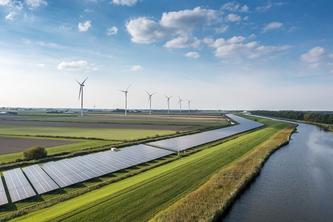
Because plants need carbon dioxide to grow, scientists have expected rising atmospheric CO2 to substantially enhance plant growth, offsetting a portion of human CO2 emissions and, in turn, slowing climate change. However, new research from the Institute on the Environment published today in Nature Climate Change adds to a growing body of research challenging this expectation.
The study, led by William Kolby Smith, a Luc Hoffman Institute postdoctoral fellow working with IonE’s Global Landscapes Initiative and the Natural Capital Project, found that global plant growth has indeed increased over the past 30 years, but not as much as expected given the change in atmospheric CO2 concentrations. Comparing their findings with results of widely used on-the-ground measurements and the best available models of plant responses to increasing CO2, Smith and colleagues concluded that current model estimates of plants’ ability to offset growing greenhouse gas emissions may be unrealistically optimistic.
“Current Earth system models assume that global plant growth will provide the tremendous benefit of offsetting a significant portion of humanity’s CO2 emissions, thus buying us much needed time to curb emissions,” says Smith. “Unfortunately, our observation-based estimates of global vegetation growth indicate that plant growth may not buy us as much time as expected, [so] action to curb emissions is all the more urgent.”
The authors identify two important factors that could be driving the divergence between satellite-based results and model-based results: availability of water and availability of nutrients. Satellite data indicate that warmer climate conditions resulting from rising atmospheric CO2 may be increasing plant water stress, counteracting any positive effect of CO2. Additionally, limited availability of nitrogen and phosphorus in the environment could also limit the ability of plants to soak up additional CO2 (see also previous work co-authored by Smith).
These findings indicate that current climate models do not accurately predict future plant growth and suggest that allowable emissions targets based on these models may need reevaluation. The authors recommend better integration among model, satellite and on-the-ground measurement approaches to improve our understanding of the effects of rising atmospheric CO2 on plant growth.
The work provides an important step forward in the understanding of how plants may respond (or not respond) to rising atmospheric CO2, as well as highlights ways scientists from different specialties can work together to reach a deeper understanding of how ecosystems will respond to global change, says Sasha Reed, a U.S. Geological Survey scientist and co-author of the paper. “We have many scientific tools in our toolbox, and bringing them together is a powerful approach to asking questions and to solving problems.”
The University of Minnesota’s Institute on the Environment seeks lasting solutions to Earth’s biggest challenges through research, partnerships and leadership development. For more information, visit environment.umn.edu.
# # #
This work was supported by the US Geological Survey Ecosystems Mission Area, US Department of Energy Terrestrial Ecosystem Sciences Program (Award no. DE-SC-0008168), the US Geological Survey John Wesley Powell Center for Analysis and Synthesis, and the NASA Earth Observing System MODIS project (grant no. NNX08AG87A). Y.Y.L. is supported by an Australian Research Council DECRA Fellowship (project number DE140100200).
Citation:
Smith, W.K., Reed, S.C., Cleveland, C.C., Ballantyne, A.P., Anderegg, W.R.L., Wieder, W.R., Liu, Y.Y., Running, S.W. 2015. Large divergence of satellite and Earth system model estimates of global terrestrial CO2 fertilization. Nature Climate Change DOI: 10.1038/nclimate2879.
- Categories:
- Agriculture and Environment





